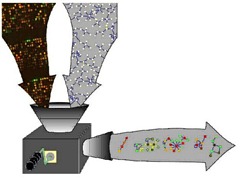The Magic Crank
As a brief addendum to my previous post: I've been using this image for a few years now to illustrate what the Semantic Web is not. I call it the magic crank. I imagine that it sits in the corner of the office of some senior pharma executive, and every time their drug development pipeline gets a bit thin or patent protection for the big blockbuster drugs wears off, the executive pulls it out. She dusts off the crank and plugs in the latest databases full of data on genomics, protein interactions, efficacy and safety studies, etc. A few turns of the magic crank later, and she's rewarded with a little card that tells her exactly what drug to invest in next.
To me, the magic crank is the unrealized holy grail of the Semantic Web in the pharma industry. And it's an extremely powerful and valuable goal. But it's a bit dangerous as well: every time someone new to the Semantic Web learns that the magic crank is what the Semantic Web is all about, they end up trying to tackle large, unsolved problems. They end up asking "What can I do with Semantic Web technologies that I can't do otherwise?". Once you've latched onto the potential of the magic crank, it's very hard to ratchet your questions back down to the less-impressive-but-practical-and-still-very-valuable, "What can I do with Semantic Web technologies that I wouldn't do otherwise?".
Credit for the image goes to Trey Ideker of UCSD. I first saw the image in a presentation by Enoch Huang at CSHALS a few years ago.
